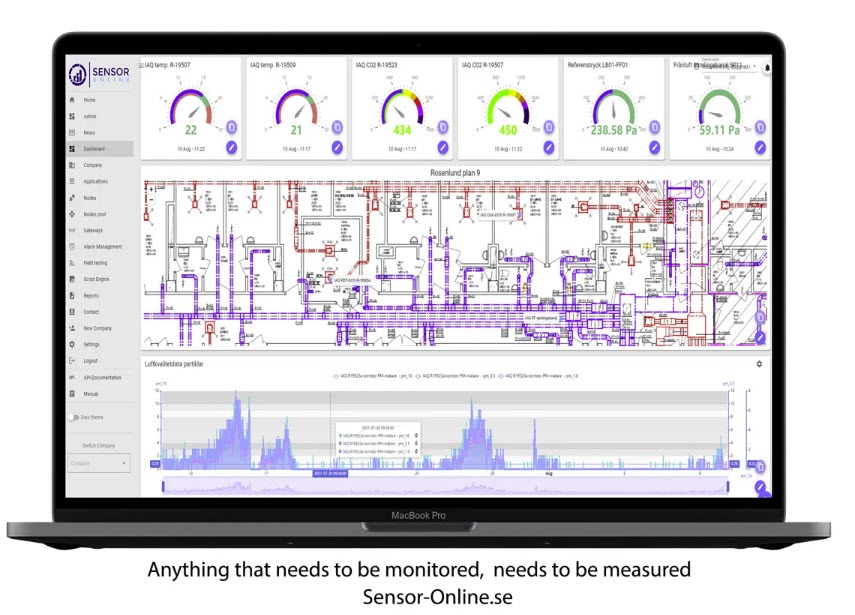IoT Sensors in Water Quality and Environmental Monitoring
You have the option to use Sensor-Online, a versatile IoT platform to collect the sensordata that have been sent using wired or wirelessly transmit sensor data from remote battery-operated loggers via LoRaWAN or cellular technologies. This data can then be converted to Modbus or OPC protocols if needed, ensuring seamless integration with existing PLCs or SCADA systems.
The integration of IoT sensors with PLCs and SCADA systems is transforming industrial automation and environmental monitoring. By enabling real-time data acquisition, analysis, and control, this combination enhances efficiency, safety, and operational optimization.
20 Applications of IoT Sensors in Water Quality and Environmental Monitoring
- Groundwater Monitoring
- IoT sensors monitor groundwater levels, ensuring sustainable water usage and preventing over-extraction.
- Water Monitoring: Turbidity and Total Suspended Solids (TSS)
- Monitoring turbidity and TSS helps in assessing water clarity and quality, crucial for aquatic ecosystems and drinking water safety.
- Salinity Monitoring
- IoT sensors detect changes in salinity, essential for managing freshwater resources and agricultural practices.
- Dissolved Oxygen Monitoring
- Real-time monitoring of dissolved oxygen levels helps in maintaining healthy aquatic environments and preventing fish kills.
- pH Level Monitoring
- pH sensors provide critical data for managing water acidity or alkalinity, important in industries like aquaculture and water treatment.
- Conductivity Monitoring
- Conductivity sensors measure the water’s ability to conduct electricity, indicating the presence of dissolved salts and other chemicals.
- Temperature Monitoring
- Temperature sensors are used to monitor water temperature, affecting chemical reactions and biological processes in water bodies.
- Water Depth Monitoring
- Monitoring water depth is vital for flood management, reservoir operations, and environmental studies.
- E. coli and Total Coliform Monitoring
- IoT sensors detect harmful bacteria like E. coli, ensuring water safety for drinking, recreation, and irrigation.
- Blue/Green Algae Monitoring
- Continuous monitoring of algae levels helps in managing algal blooms, which can be harmful to both aquatic life and human health.
- Chlorophyll-A Monitoring
- Chlorophyll-A sensors help in assessing the photosynthetic activity in water bodies, indicating the presence of algae and overall water health.
- Flood Detection and Management
- IoT sensors provide real-time data on water levels and flow rates, essential for early flood detection and disaster management.
- Stormwater Monitoring
- Sensors monitor stormwater quality, detecting pollutants and preventing contamination of natural water bodies.
- River and Stream Monitoring
- IoT sensors are used to continuously monitor the health of rivers and streams, ensuring sustainable water management practices.
- Catchment Area Monitoring
- Monitoring water quality in catchment areas helps in protecting water resources from pollution and overuse.
- Industrial Effluent Monitoring
- IoT sensors track the discharge of industrial effluents into water bodies, ensuring compliance with environmental regulations.
- Agricultural Runoff Monitoring
- Monitoring nutrient levels in agricultural runoff helps in preventing water pollution and managing fertilizer usage.
- Aquaculture Monitoring
- IoT sensors monitor water quality in aquaculture farms, ensuring optimal conditions for fish and other aquatic organisms.
- Reservoir Management
- Continuous monitoring of water quality and levels in reservoirs ensures efficient water storage and distribution.
- Environmental Impact Assessment
- IoT sensors provide data for assessing the environmental impact of various industrial and agricultural activities, aiding in sustainable development.
Benefits of Using IoT Sensors with PLC and SCADA
The integration of IoT sensors with PLC and SCADA systems offers numerous benefits, including:
- Real-Time Data Collection: IoT sensors provide continuous monitoring, ensuring that data is always up-to-date and actionable.
- Enhanced Decision-Making: The real-time data processed by PLCs and visualized by SCADA systems enable quick and informed decision-making.
- Cost Efficiency: Automated monitoring reduces the need for manual inspections, lowering operational costs.
- Improved Safety: Continuous monitoring and control help in early detection of issues, preventing accidents and environmental hazards.
- Scalability: IoT-based systems are easily scalable, allowing industries to expand their monitoring capabilities as needed.
Conclusion
The combination of IoT sensors with PLC and SCADA systems is a game-changer in the field of water quality and environmental monitoring. By providing real-time, accurate data, these technologies enable industries to optimize their processes, ensure regulatory compliance, and protect the environment. The 20 applications discussed above highlight the versatility and effectiveness of IoT sensors in various water-related monitoring tasks, demonstrating their critical role in modern industrial and environmental management.


